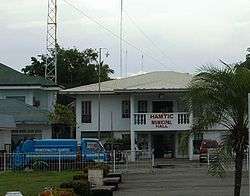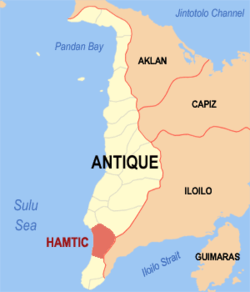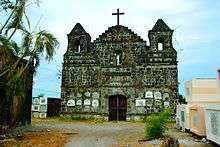Hamtic
Hamtic, officially the Municipality of Hamtic, (Kinaray-a: Banwa kang Hamtic; Hiligaynon: Banwa sang Hamtic; Tagalog: Bayan ng Hamtic), is a 3rd class municipality in the province of Antique, Philippines. According to the 2015 census, it has a population of 48,592 people.[3]
Hamtic | |
|---|---|
| Municipality of Hamtic | |
 Municipal hall | |
| Etymology: Fire ant | |
 Map of Antique with Hamtic highlighted | |
OpenStreetMap 
| |
.svg.png) Hamtic Location within the Philippines | |
| Coordinates: 10°42′N 121°59′E | |
| Country | |
| Region | Western Visayas (Region VI) |
| Province | Antique |
| District | Lone district |
| Chartered | January 20, 1954 |
| Barangays | 47 (see Barangays) |
| Government | |
| • Type | Sangguniang Bayan |
| • Mayor | Julius D. Pacificador |
| • Vice Mayor | Julius Ronald L. Pacificador |
| • Congressman | Loren Legarda |
| • Electorate | 28,964 voters (2019) |
| Area | |
| • Total | 113.03 km2 (43.64 sq mi) |
| Population (2015 census)[3] | |
| • Total | 48,592 |
| • Density | 430/km2 (1,100/sq mi) |
| • Households | 10,501 |
| Economy | |
| • Income class | 3rd municipal income class |
| • Poverty incidence | 20.82% (2015)[4] |
| • Revenue (₱) | 105,445,062.96 (2016) |
| Time zone | UTC+8 (PST) |
| ZIP code | 5715 |
| PSGC | |
| IDD : area code | +63 (0)36 |
| Climate type | tropical climate |
| Native languages | Kinaray-a language Ati Hiligaynon Tagalog |
Hamtic was formerly named Antique, after which the province was named. It is the oldest town and the first capital of the province before it was transferred to San Jose de Buenavista in 1802. The town speaks three dialects, namely Hamtikanon (a unique town dialect), Karay-a (the lingua franca of Antique province), and Hiligaynon (the regional dialect).[5]
“Hantik” was named after the humming big black ants that produce the sound “tik” when they bite.
History
Hamtic or Hamtik is the oldest town in Antique. It was the first capital of the province during the Spanish regime. Later, San Jose de Buenavista was made capital by the Spaniards in 1802. Hamtic was then relegated to a mere barrio, forming a part of San Jose.
Local historians tell how Hamtic came to be thru its legend. During the 13th century, at the time that Sulu experienced a change from the high influence of Banjarmasin, Borneo was full of discontentment. The leader of Borneo then was Sultan Makatunaw, known for its cruelty and greediness. To escape from his wrath, the ten datus led by datu Puti sailed away in their “balangays” in search of freedom in a new and peaceful land. The other nine (9) datus were Datu sumakwel, Bangkaya, Paiburong, Padohinog, Lubay , Dumalugdog, Dumangsil, Dumangsol and Balinsusa. Strong winds and tides brought this group of sailors, businessmen, sculptors, farmers, blacksmiths/carpenters and spiritual babaylan to the Sirawagan River, once a portion of Antique but presently claimed by San Joaquin, Iloilo. Nearby lies the Andona Creek where these foreigners met with the natives, black, short and kinky-haired inhabitants called atis or negritoes as the Spaniards used to call them. The leader of the datus, datu Puti met with Datu Marikudo, heir of datu Polpolan, the chieftain of the Atis, who immediately asked what they (the foreigners) wanted. Datu Puti replied that they need to purchase a land they can call their own and where they can live peacefully. Marikudo readily agreed to allow them to occupy the area near the sea while the Atis will occupy the hillsides and the mountainous part. The agreement would be done with a barter. The Atis were happy with what they got – a gold salakot, a long necklace and a gold “batya”. Unluckily, the land that the datus purchased run out of food, water and other provisions. Datu Puti sent Datu Sumakwel to travel north with a group of other Datus’ wives, “bangut-banwa”, guides and the rest. They reached the shores of Hantik, and later anchored at Malandog or “Malindog” (tabungos). They sailed towards the mouth of the two rivers, Bocboc and Malandog and carefully anchored thereat. Datu Sumakwel went around the land and found out that there was abundance of harvest in the fields and foods from the seas and wild animals in the hills and mountains. He then went back to Sirawagan to report to Datu Puti what he had discovered. Datu Puti then called everyone to prepare to sail northbound, to Malandog. Later, Datu Puti sailed north from Malandog and reached the provinces of Batangas, Laguna and to other parts of Luzon. With him were Datu Dumangsil and Datu Balinsusa. Meanwhile, Datu Sumakwel became the most respected leader of Hamtic and later the whole of Panay.
Hamtik was already a flourishing Malayan settlement when the Spaniards came to Panay. However, the settlement was later renamed Antique by the Spaniards and made the first capital of the province, which later on became the name of the whole province. In 1762, the seat of the Province was transferred to Bugasong, another progressing Spanish Settlement, but in 1802 it was moved to San Jose de Buenavista, the present capital of the Province of antique. The town of Hamtic was created separately from the Municipality of San Jose by virtue of Executive Order No. 3, series of 1954 signed by President Ramon Magsaysay and was officially inaugurated on January 20, 1954. Since then, the Municipality is celebrating its birth anniversary.[6]
Geography
Hamtic is 7 kilometres (4.3 mi) from the provincial capital, San Jose de Buenavista.
According to the Philippine Statistics Authority, the municipality has a land area of 113.03 square kilometres (43.64 sq mi) [2] constituting 4.14% of the 2,729.17-square-kilometre- (1,053.74 sq mi) total area of Antique.
Climate
| Climate data for Hamtic, Antique | |||||||||||||
|---|---|---|---|---|---|---|---|---|---|---|---|---|---|
| Month | Jan | Feb | Mar | Apr | May | Jun | Jul | Aug | Sep | Oct | Nov | Dec | Year |
| Average high °C (°F) | 30 (86) |
31 (88) |
32 (90) |
33 (91) |
32 (90) |
30 (86) |
29 (84) |
29 (84) |
29 (84) |
29 (84) |
30 (86) |
30 (86) |
30 (87) |
| Average low °C (°F) | 21 (70) |
21 (70) |
22 (72) |
23 (73) |
25 (77) |
25 (77) |
25 (77) |
25 (77) |
24 (75) |
24 (75) |
23 (73) |
22 (72) |
23 (74) |
| Average precipitation mm (inches) | 19 (0.7) |
17 (0.7) |
26 (1.0) |
37 (1.5) |
119 (4.7) |
191 (7.5) |
258 (10.2) |
260 (10.2) |
248 (9.8) |
196 (7.7) |
97 (3.8) |
39 (1.5) |
1,507 (59.3) |
| Average rainy days | 7.2 | 5.2 | 8.3 | 11.9 | 22.3 | 26.5 | 28.3 | 28.2 | 27.3 | 26.4 | 18.7 | 11.8 | 222.1 |
| Source: Meteoblue (modeled/calculated data, not measured locally)[7] | |||||||||||||
Barangays
Hamtic is politically subdivided into 47 barangays.[8]
| PSGC | Barangay | Population | ±% p.a. | |||
|---|---|---|---|---|---|---|
| 2015[3] | 2010[9] | |||||
| 060608001 | Apdo | 1.7% | 818 | 798 | 0.47% | |
| 060608002 | Asluman | 4.7% | 2,296 | 2,041 | 2.27% | |
| 060608003 | Banawon | 2.2% | 1,069 | 1,043 | 0.47% | |
| 060608005 | Bia-an | 2.2% | 1,089 | 1,087 | 0.04% | |
| 060608006 | Bongbongan I-II | 1.6% | 764 | 790 | −0.64% | |
| 060608008 | Bongbongan III | 1.0% | 475 | 425 | 2.14% | |
| 060608009 | Botbot | 0.9% | 449 | 392 | 2.62% | |
| 060608010 | Budbudan | 2.2% | 1,076 | 873 | 4.06% | |
| 060608011 | Buhang | 4.4% | 2,159 | 1,960 | 1.86% | |
| 060608012 | Calacja I | 1.8% | 878 | 827 | 1.15% | |
| 060608013 | Calacja II | 1.9% | 904 | 873 | 0.67% | |
| 060608014 | Calala | 1.7% | 802 | 769 | 0.80% | |
| 060608015 | Cantulan | 0.4% | 180 | 194 | −1.42% | |
| 060608016 | Caridad | 4.2% | 2,043 | 1,940 | 0.99% | |
| 060608017 | Caromangay | 1.3% | 627 | 622 | 0.15% | |
| 060608018 | Casalngan | 1.3% | 613 | 589 | 0.76% | |
| 060608019 | Dangcalan | 0.8% | 398 | 348 | 2.59% | |
| 060608020 | Del Pilar | 0.6% | 277 | 326 | −3.05% | |
| 060608021 | Fabrica | 1.4% | 688 | 678 | 0.28% | |
| 060608022 | Funda | 4.7% | 2,298 | 2,141 | 1.36% | |
| 060608023 | General Fullon (Tina) | 1.4% | 703 | 672 | 0.86% | |
| 060608030 | Gov. Evelio B. Javier (Lanag) | 3.8% | 1,844 | 1,694 | 1.63% | |
| 060608024 | Guintas | 4.7% | 2,264 | 2,165 | 0.85% | |
| 060608025 | Igbical | 1.3% | 618 | 583 | 1.12% | |
| 060608026 | Igbucagay | 1.2% | 561 | 491 | 2.57% | |
| 060608027 | Inabasan | 1.6% | 787 | 762 | 0.62% | |
| 060608028 | Ingwan-Batangan | 2.0% | 989 | 964 | 0.49% | |
| 060608029 | La Paz | 4.1% | 2,000 | 1,791 | 2.12% | |
| 060608031 | Linaban | 3.2% | 1,538 | 1,414 | 1.61% | |
| 060608033 | Malandog | 4.0% | 1,959 | 1,941 | 0.18% | |
| 060608034 | Mapatag | 4.1% | 1,979 | 1,799 | 1.83% | |
| 060608035 | Masanag | 1.6% | 800 | 716 | 2.13% | |
| 060608036 | Nalihawan | 0.6% | 276 | 307 | −2.01% | |
| 060608037 | Pamandayan (Botbot) | 0.4% | 172 | 152 | 2.38% | |
| 060608038 | Pasu-Jungao | 0.3% | 151 | 157 | −0.74% | |
| 060608039 | Piape I | 3.0% | 1,442 | 1,331 | 1.54% | |
| 060608040 | Piape II | 1.3% | 612 | 608 | 0.12% | |
| 060608041 | Piape III | 2.3% | 1,101 | 1,411 | −4.61% | |
| 060608042 | Pili 1, 2, 3 | 0.7% | 337 | 336 | 0.06% | |
| 060608045 | Poblacion 1 | 2.0% | 964 | 953 | 0.22% | |
| 060608046 | Poblacion 2 | 1.8% | 887 | 862 | 0.55% | |
| 060608047 | Poblacion 3 | 1.4% | 658 | 607 | 1.55% | |
| 060608048 | Poblacion 4 | 2.1% | 1,020 | 1,011 | 0.17% | |
| 060608049 | Poblacion 5 | 3.5% | 1,680 | 1,590 | 1.05% | |
| 060608050 | Pu-ao | 2.1% | 1,040 | 980 | 1.14% | |
| 060608051 | Suloc | 0.2% | 117 | 115 | 0.33% | |
| 060608053 | Villavert-Jimenez | 4.5% | 2,190 | 1,855 | 3.21% | |
| Total | 48,592 | 45,983 | 1.06% | |||
Demographics

|
| ||||||||||||||||||||||||||||||||||||
| Source: Philippine Statistics Authority[3][9][10][11] | |||||||||||||||||||||||||||||||||||||
In the 2015 census, Hamtic had a population of 48,592.[3] The population density was 430 inhabitants per square kilometre (1,100/sq mi).
Tourism
The latest edition to the strings of tourist attractions found in Hamtic, aside from the hero’s birthplace, is the Rosa Mystica Park in Barangay EBJ (formerly Barangay Lanag) where soul-searchers can have a corner to come to and to meditate. The Park boasts of statues depicting the Lord’s Via Crucis and is situated on top of a hill, also Rosa Mystica’s image, thus the park is named. It can be reached by tricycle and has minimal entrance fee. It is open daily to accommodate local and foreign visitors.
References
- "Municipality". Quezon City, Philippines: Department of the Interior and Local Government. Retrieved 31 May 2013.
- "Province: Antique". PSGC Interactive. Quezon City, Philippines: Philippine Statistics Authority. Retrieved 12 November 2016.
- Census of Population (2015). "Region VI (Western Visayas)". Total Population by Province, City, Municipality and Barangay. PSA. Retrieved 20 June 2016.
- "PSA releases the 2015 Municipal and City Level Poverty Estimates". Quezon City, Philippines. Retrieved 12 October 2019.
- "Hamtic". Official Antique Website. 2012. Archived from the original on 19 August 2012. Retrieved 11 February 2013.
- "Executive Order No. 3, s. 1954 | GOVPH". Official Gazette of the Republic of the Philippines. Retrieved 2018-12-24.
- "Hamtic: Average Temperatures and Rainfall". Meteoblue. Retrieved 1 May 2020.
- "Municipal: Hamtic". PSGC Interactive. Quezon City, Philippines: Philippine Statistics Authority. Retrieved 8 January 2016.
- Census of Population and Housing (2010). "Region VI (Western Visayas)". Total Population by Province, City, Municipality and Barangay. NSO. Retrieved 29 June 2016.
- Censuses of Population (1903–2007). "Region VI (Western Visayas)". Table 1. Population Enumerated in Various Censuses by Province/Highly Urbanized City: 1903 to 2007. NSO.
- "Province of Antique". Municipality Population Data. Local Water Utilities Administration Research Division. Retrieved 17 December 2016.
External links
| Wikimedia Commons has media related to Hamtic, Antique. |